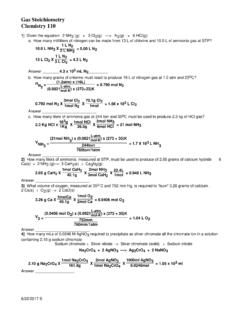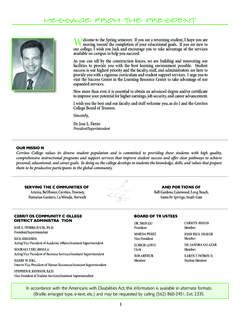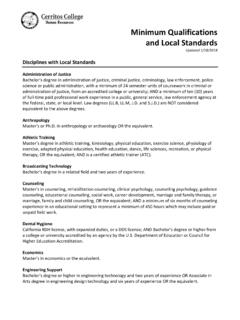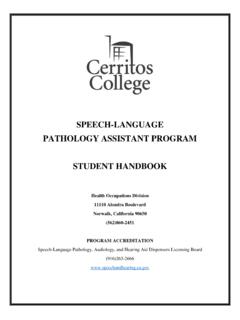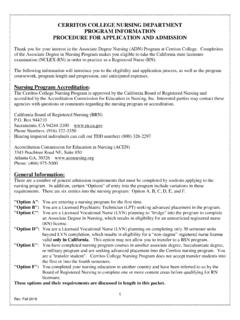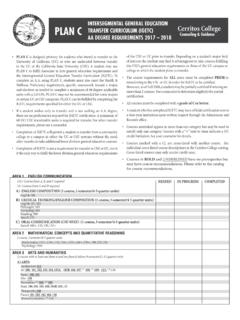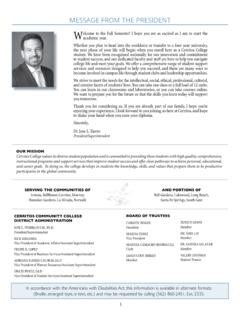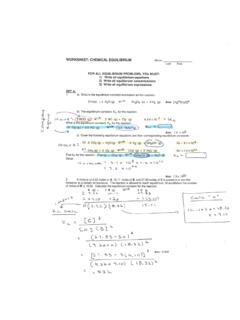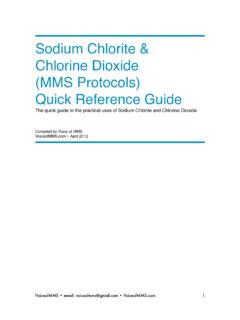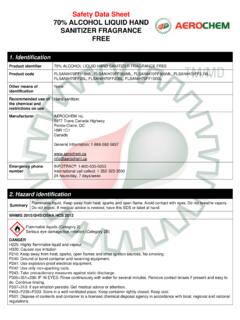Transcription of Chem 112 OXIDATION-REDUCTION EXPERIMENT
1 Chem 112 OXIDATION-REDUCTION EXPERIMENT . INTRODUCTION. An OXIDATION-REDUCTION (redox) reaction involves the movement of electrons from one reactant to another. Many reactions that you have already studied are redox reactions; these include single replacement, combustion, and combination. Oxidation is the loss of electrons. Reduction is the gain of electrons. The loss and gain of electrons occur simultaneously in the reaction. For example, in the reaction of elemental calcium and oxygen to produce calcium oxide: Ca(s) + O 2 (g) CaO(s).
2 Calcium loses two electrons and oxygen gains two electrons. Although the two events occur simultaneously, they may be written as two separate half-reactions: Reduction half-reaction: 2 e- + O 2 O2- Oxidation half-reaction: Ca Ca2+ + 2 e- In this reaction, O 2 is the oxidizing agent. The oxidizing agent is the species that is being reduced (gaining electrons). The reducing agent is the species that is being oxidized (losing electrons). The reducing reagent in this reaction is Ca. An OXIDATION-REDUCTION reaction may be thought of as a competition between two substances for electrons.
3 Consider the two reactions below, which are the reverse of each other: Reaction (1) Cu(NO 3 ) 2 (aq) + Zn(s) Cu(s) + Zn(NO 3 ) 2 (aq). net ionic equation: Cu2+(aq) + Zn(s) Cu(s) + Zn2+ (aq). reduction half-reaction: Cu2+ (aq) + 2 e- Cu(s). oxidation half-reaction: Zn(s) Zn2+ (aq) + 2 e- oxidizing agent = Cu2+. reducing agent = Zn Reaction (2) Zn(NO 3 ) 2 (aq) + Cu(s) Zn(s) + Cu(NO 3 ) 2 (aq). net ionic equation: Zn2+(aq) + Cu(s) Zn(s) + Cu2+(aq). reduction half-reaction: Zn2+ (aq) + 2 e- Zn(s). oxidation half-reaction: Cu(s) Cu2+(aq) + 2 e- oxidizing agent = Zn2+.
4 Reducing agent = Cu Reaction (1) will occur spontaneously and (2) will not if Cu2+ is a stronger oxidizing agent than Zn2+. Conversely, reaction (2) will occur and (1) will not if Zn2+ is a stronger oxidizing agent than Cu2+ (and Cu is a stronger reducing agent than Zn). That is, a redox reaction will occur spontaneously to produce the weaker oxidizing and reducing agents. 1. A standard OXIDATION-REDUCTION potential series (standard potential series) is a list of reduction half-reactions. The half-reactions are listed such that the reduction half-reaction for the strongest oxidizing agent is written first, followed by the next strongest, and so on.
5 Since the strongest oxidizing agent produces the weakest reducing agent, as you proceed down the right side (product side) of the series, the reducing agents will be progressively stronger, as shown on the next page. OXIDATION-REDUCTION Potential Series oxidizing reducing agents agents stronger oxidizing agent reactant + e- product weaker reducing agent reactant + e- product reactant + e- product reactant + e- product reactant + e- product reactant + e- product reactant + e- product reactant + e- product reactant + e- product weaker oxidizing agent reactant + e- product stronger reducing agent reduction half-reactions In this EXPERIMENT you will use experimental evidence and additional information to write a potential series for some cations.
6 Halogens, and hydrogen ion. 2. EXPERIMENT . A. Potential Series for metals and Hydrogen The reactions you will carry out to determine a potential series for metals and hydrogen will be done in the separate wells of a spot plate. In each case a single piece of metal will be added to approximately 5 drops of solution in a spot plate well. Use a paper towel under the spot plate to label the separate reactions. In some cases, the reaction mixtures must be disposed of in special waste containers, therefore, those reactions should be carried out separately from others that is only one well of the spot plate should be used if that well contains material that requires special disposal.
7 Read carefully and plan ahead! NOTE: Some reactions are slow. If a reaction does not occur immediately, do another part of the EXPERIMENT and then go back and examine the well after ten to fifteen minutes. 1. Copper and Zinc Safety Caution: COPPER (II) NITRATE Solution: STRONG OXIDIZER. HARMFUL IF SWALLOWED. CAUSES IRRITATION TO SKIN, EYES AND RESPIRATORY TRACT. ZINC NITRATE Solution: CAUSES IRRITATION. HARMFUL IF SWALLOWED. STRONG OXIDIZER. Place a piece of each metal into M aqueous solutions of the nitrates of the other metal . That is, place copper in aqueous zinc nitrate; place zinc in aqueous copper (II) nitrate in separate wells in a spot plate.
8 Examine each reaction mixture and record your observations on the Report Sheet. If you conclude from your observations that a reaction has occurred, write its net ionic equation. If no reaction occurs, do not write an equation, write DISPOSAL: Dispose of reaction mixtures (pieces of unreacted metals plus solutions) on spot plate by pouring them all into the waste container labeled Ag and metals.. On your report sheet, indicate for each pair of ions given which is the stronger oxidizing agent. 2. Silver, Copper, and Zinc SAFETY CAUTION: SILVER NITRATE: WARNING!
9 CAUSES SEVERE EYE IRRITATION. HARMFUL IF. SWALLOWED OR INHALED. CAUSES IRRITATION TO SKIN AND RESPIRATORY TRACT. AFFECTS EYES, SKIN AND RESPIRATORY TRACT. FURTHERMORE, SILVER NITRATE. WILL STAIN YOUR SKIN AND CLOTHING. Add a piece of each metal, copper and zinc, to aqueous silver nitrate solution in separate wills of a spot plate. Examine each reaction mixture and record your observations on the Report Sheet. If you conclude from your observations that a reaction has occurred, write its net ionic equation. If no reaction occurs, do not write an equation, write DISPOSAL: Dispose of reaction mixtures (pieces of unreacted metals plus solutions) on spot plate by pouring them all into the proper waste container.
10 3. On your report sheet incorporate silver ion, copper (II), and zinc ion into a potential series ions so that your OXIDATION-REDUCTION potential series consists of reduction half-reactions for all three metal cations listed in order such that the reaction of the strongest oxidizing agent is written first and the weakest last. 3. Hydrogen, Silver, Copper, and Zinc SAFETY CAUTION: HYDROCHLORIC ACID SOLUTION: POISON! CORROSIVE. liquid AND MIST CAUSE. SEVERE BURNS TO BODY TISSUE. MAY BE FATAL IF SWALLOWED OR INHALED. Add a piece of each metal, silver, copper, and zinc, to 6 M hydrochloric acid solution in separate wells of a spot plate.
